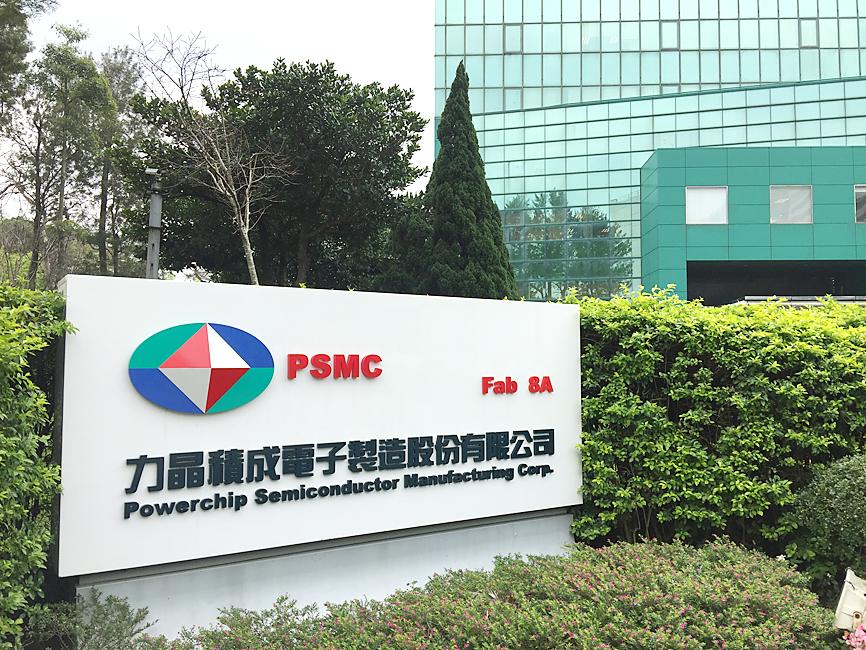Shares of Powerchip Semiconductor Manufacturing Corp (力積電), the world’s seventh-largest foundry, yesterday surged 223 percent on their first day on the Emerging Stock Board, boosting the company’s market capitalization to NT$260.8 billion (US$9.15 billion).
Powerchip’s market value surpassed that of its closest rival, Vanguard International Semiconductor Co (世界先進) valued at NT$210.8 billion, based on its share price of NT$128.5 yesterday.
Powerchip shares skyrocketed to touch NT$84 soon after the market opened in the morning, from the subscription price of NT$26 per share. The stock opened at NT$55.7.

Photo: Hung Yu-fang, Taipei Times
About 1.3 billion Powerchip shares changed hands, making it the most heavily traded stock on the board.
Last week, Powerchip gave an upbeat business outlook for this quarter and next year, saying that 8-inch capacity constraints have triggered panic among its customers. The company would raise prices to cope with capacity scarcity, it said.
As working from home, online learning and the stay-at-home economy stimulated demand for laptops and other devices, Powerchip said it has seen a spike in demand for display driver and power management ICs.
Its DRAM business is close to a breakeven level this quarter, the company added.
Powerchip’s revenue recovered to NT$3.98 billion in October, soaring 30.78 percent from NT$3.05 billion a year earlier. In the first 10 months of this year, revenue surged about 84 percent year-on-year to NT$37.79 billion from NT$20.56 billion.
Yuanta Investment Consulting Co (元大投顧) in a note ahead of Powerchip’s stock debut said that the foundry would next year benefit from 8-inch wafer capacity constraints, as it plans to expand its 8-inch wafer capacity by 20 percent and hike prices.
“We believe increases in average selling price and sales volume will be Powerchip’s major growth drivers in 2021,” Yuanta said on Tuesday.
Powerchip plans to raise prices by 5 percent to 10 percent next year, the note said.
Rising demand for power management ICs and improving DRAM chip business are also to drive the chipmaker’s financial performance, Yuanta added.
Yesterday’s debut marked a comeback for Powerchip, which was delisted from the Taipei Exchange in 2012 due to deep debts.
After a major restructuring aiming to minimize operational risk, Powerchip has transformed into a supplier of DRAM chips and provides contract manufacturing services for logic chips, including image sensor, display driver and power management ICs.
The company previously solely produced DRAM chips and relied on technology support from its Japanese partner, Elpida Inc, which was later acquired by US-based Micron Technology Inc.

TECH BOOST: New TSMC wafer fabs in Arizona are to dramatically improve US advanced chip production, a report by market research firm TrendForce said With Taiwan Semiconductor Manufacturing Co (TSMC, 台積電) pouring large funds into Arizona, the US is expected to see an improvement in its status to become the second-largest maker of advanced semiconductors in 2027, Taipei-based market researcher TrendForce Corp (集邦科技) said in a report last week. TrendForce estimates the US would account for a 21 percent share in the global advanced integrated circuit (IC) production market by 2027, sharply up from the current 9 percent, as TSMC is investing US$65 billion to build three wafer fabs in Arizona, the report said. TrendForce defined the advanced chipmaking processes as the 7-nanometer process or more

China’s Huawei Technologies Co (華為) plans to start mass-producing its most advanced artificial intelligence (AI) chip in the first quarter of next year, even as it struggles to make enough chips due to US restrictions, two people familiar with the matter said. The telecoms conglomerate has sent samples of the Ascend 910C — its newest chip, meant to rival those made by US chipmaker Nvidia Corp — to some technology firms and started taking orders, the sources told Reuters. The 910C is being made by top Chinese contract chipmaker Semiconductor Manufacturing International Corp (SMIC, 中芯) on its N+2 process, but a lack

Who would not want a social media audience that grows without new content? During the three years she paused production of her short do-it-yourself (DIY) farmer’s lifestyle videos, Chinese vlogger Li Ziqi (李子柒), 34, has seen her YouTube subscribers increase to 20.2 million from about 14 million. While YouTube is banned in China, her fan base there — although not the size of YouTube’s MrBeast, who has 330 million subscribers — is close to 100 million across the country’s social media platforms Douyin (抖音), Sina Weibo (新浪微博) and Xiaohongshu (小紅書). When Li finally released new videos last week — ending what has

NVIDIA PLATFORM: Hon Hai’s Mexican facility is to begin production early next year and a Taiwan site is to enter production next month, Nvidia wrote on its blog Hon Hai Precision Industry Co (鴻海精密), the world’s biggest electronics manufacturer, yesterday said it is expanding production capacity of artificial intelligence (AI) servers based on Nvidia Corp’s Blackwell chips in Taiwan, the US and Mexico to cope with rising demand. Hon Hai’s new AI-enabled factories are to use Nvidia’s Omnivores platform to create 3D digital twins to plan and simulate automated production lines at a factory in Hsinchu, the company said in a statement. Nvidia’s Omnivores platform is for developing industrial AI simulation applications and helps bring facilities online faster. Hon Hai’s Mexican facility is to begin production early next year and the